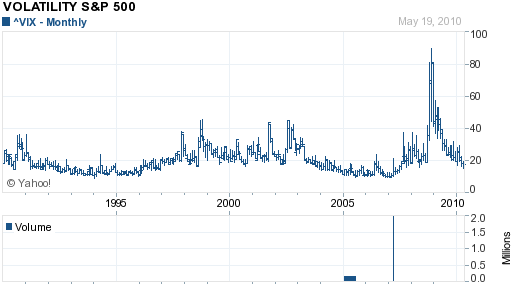The reason why you hold cash, as opposed to yield-bearing investments, is to take advantages such as times as this one and be able to purchase securities at low prices.
Right now, the markets are trading heavily down, presumably as a function of some fallout of the European economic situation and a not-so-hot US jobs report.
In the 21st century world, at least in western countries, the reality is that employment is not a proxy for corporate profitability. An investor invests to get a claim on a company’s cash flows or assets.
The following is a monthly chart of the S&P 500 volatility index, which is at around 45 right now:
The volatility of the main indexes are such that are equaling what happened during 9/11 and the Enron/Worldcom blowup. The only bigger spike in volatility was when Lehman Brothers went belly-up. This European sovereign debt crisis is nothing close to what happened during the Lehman Brothers time (late 2008). Although Greece is a canary in a coal mine, it is not that important in the grand scheme of economics.
The one thing I do know about markets is that there will never be a grand pronouncement that this volatility spike is ending. It could go to 50, or 60, or 70, but it could just float down from this point. One never knows. If I was going to guess, this financial soap opera has another month of legs left in it.
What a good investor does, and a good investor holds onto cash for this reason: to pick off the targets on your watchlist, that are being sold by international financial institutions carte blanche, that are trading well below what your assumed fair value for the securities are.
